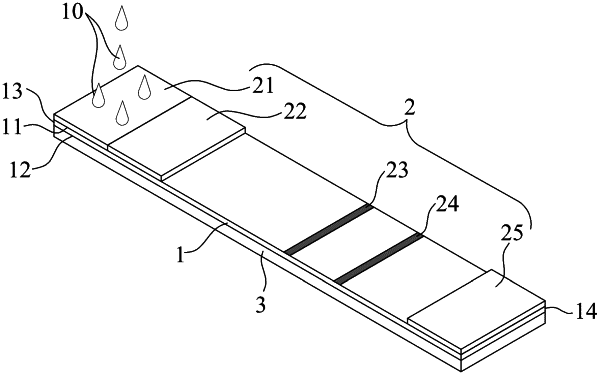| CPC G01N 33/54386 (2013.01) [G01N 33/558 (2013.01)] | 5 Claims |

|
1. An immunochromatographic detection device adapted for detecting an analyte in a specimen, comprising:
a surface-modified cellulose membrane that includes
opposite top and bottom surfaces, said top surface having opposite first and second end portions,
a plurality of cellulose fibers, and
an anti-biofouling acrylic copolymer which is bonded to said cellulose fibers using ammonia as a catalyst and which is made from a first compound and a second compound, said first compound being selected from the group consisting of glycidyl methacrylate, hydroxyethylmethacrylate, CH2═C(CH3)—C(O)—O—CH2—C(O)H, and combinations thereof, and said second compound being selected from the group consisting of sulfobetaine methacrylate, sulfobetaine acrylamide, and a combination thereof, wherein a molar ratio of said first component to said second component in said anti-biofouling acrylic copolymer ranges from 30:70 to 80:20;
a detection unit that is disposed on said top surface of said surface-modified cellulose membrane, that is configured to interact with the specimen after the specimen diffuses into said surface-modified cellulose membrane, and that sequentially includes, in a direction from said first end portion towards said second end portion,
a diffusion layer for receiving and diffusing the specimen,
a capturing layer connected to said diffusion layer and including a main body and a plurality of gold nanocolloids releasably disposed on said main body, each of said gold nanocolloids including a gold nanoparticle and a first binding agent loaded on said gold nanoparticle for specifically binding to the analyte so as to form a complex,
a detection layer spaced apart from said capturing layer and including a second binding agent for specifically binding to the analyte of the complex,
a control line layer spaced apart from said detection layer and including a third binding agent for specifically binding to said gold nanocolloids, and
an absorbent layer spaced apart from said control line layer and adapted for absorbing the specimen after the specimen passes through said control line layer; and
a substrate disposed on said bottom surface of said surface-modified cellulose membrane.
|